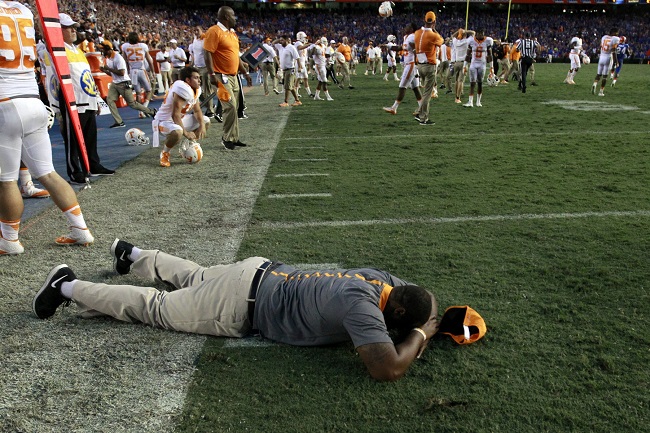
Why does Tennessee continue to blow big leads?
Blowing big leads has been the story of Tennessee’s season thus far, including last Saturday’s game against South Carolina when Tennessee blew another 17-point lead but held on to win 27-24.
Tennessee’s game against South Carolina was the fourth time this season that Tennessee has led by at least 13 points and has allowed its opponent to come back and tie the game or take a lead. This fact can’t help but make one wonder: Why do the Volunteers continue to blow big leads?
After looking over the four games in which Tennessee lost leads, one reason stands out: mistakes.
Let’s start with Tennessee’s first blown lead of the season against Oklahoma. With just over 13 minutes left in the fourth quarter and the Volunteers holding a 17-3 lead, Tennessee forced Oklahoma into a third-and-8 scenario on its own 22-yard line.
On the next play, QB Baker Mayfield threw an incomplete pass, but Tennessee ILB Colton Jumper was flagged for holding, giving Oklahoma 10 yards and an automatic first down. Five plays later, on another third-and-eight from Oklahoma’s 34-yard line, Mayfield was flushed out of the pocket and threw another wild, incomplete pass.
But, once again, Jumper was called for holding, which gave Oklahoma another automatic first down. Without the penalties, Oklahoma punts the ball to Tennessee, and gives Tennessee’s offense good field position.
Instead, Oklahoma drove down the field and scored its first touchdown, giving the previously dispirited Sooners some hope.
Then after Tennessee punted the ball back to Oklahoma, the Sooners drove the ball to Tennessee’s 27 with 4 minutes left in regulation.
On first down, Tennessee tackled Oklahoma RB Samaje Perine in the backfield for a 4-yard loss. But on second-and-14, on a pass that Mayfield threw five yards out of the back of the end zone, S Malik Foreman shoved the intended receiver and was flagged for pass interference.
Instead of Oklahoma facing third-and-14, the Sooners were given 15 yards and a fresh set of downs. Oklahoma went on to score the game-tying TD with 40 seconds left in the fourth quarter.
Two weeks later in Tennessee’s loss to Florida, the Vols had a 13-point lead at the beginning of the fourth quarter. They made only one obvious mistake in the midst of a collapse. But it proved to be costly.
With 2:18 left and ahead by six points, the Vols forced Florida into a fourth-and-14 scenario. Then on fourth down, Florida QB Will Grier completed a pass to WR Antonio Callaway beyond the first down marker.
That should have been the worst thing that happened to Tennessee on this play. But it wasn’t.
After Callaway made the catch, he should have been tackled by Foreman. But Foreman took a poor (and somewhat lazy) tackling angle toward Callaway, which allowed the Florida receiver to turn up field. WR Brandon Powell provided Callaway with a great block, springing him for the game-winning TD.
Then the next week against Arkansas, Tennessee scored 14 quick points in the first quarter. But the lead disappeared before the second quarter ended.
In the midst of losing that lead, Tennessee PK Aaron Medley missed a 28-yard field-goal attempt. The miss on the chip shot gave Arkansas momentum.After the missed field goal attempt, Arkansas drove 80 yards on four plays and tied the game 14-14.
And finally, in last Saturday’s game against South Carolina, Tennessee’s offense had the chance to keep South Carolina at arms-length if it was able to move the football on its second possession of the third quarter.
But RB Alvin Kamara fumbled and South Carolina recovered it on Tennessee’s 13, setting up a game-tying TD.
Many factors have contributed to Tennessee’s blown leads. But one thing is clear: mistakes give opponents momentum that they otherwise wouldn’t have. And often, mistakes are the difference between winning and losing.
